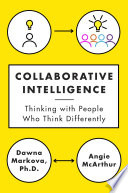

Despite the benefits of collaboration, many organizations face barriers that hinder effective teamwork. The book identifies common obstacles, such as silos, lack of communication, and conflicting priorities. It offers practical strategies for overcoming these barriers, including fostering a culture of openness, encouraging cross-functional teams, and aligning goals across departments. By addressing these challenges head-on, organizations can create a more collaborative environment that supports innovation and drives success.
Continue readingThe book emphasizes the significance of collective intelligence, which is the shared or group intelligence that emerges from the collaboration and competition of many individuals. It highlights how harnessing the collective knowledge, skills, and perspectives of a diverse group can lead to innovative solutions and improved decision-making. By leveraging the strengths of each participant, organizations can foster a culture of collaboration that not only enhances creativity but also drives productivity and efficiency. It encourages readers to move beyond individualistic approaches and recognize that teamwork can yield results that exceed the sum of its parts.
Continue readingTrust is a cornerstone of effective collaboration. The book discusses the importance of establishing trust among team members as a prerequisite for successful collaboration. It delves into strategies for building trust, such as open communication, transparency, and shared goals. When individuals feel safe and valued, they are more likely to contribute openly, share ideas, and engage in constructive feedback. The authors provide insights into fostering an environment where relationships can thrive, which ultimately leads to stronger collaborative efforts and greater innovation.
Continue readingDiversity in teams is not just a checkbox to tick; it is a vital ingredient for innovation. The book explores how diverse perspectives can lead to more creative problem-solving and innovative solutions. It argues that when people from different backgrounds, experiences, and viewpoints come together, they bring unique insights that can challenge conventional thinking and spark new ideas. The authors stress the need for organizations to actively seek out and embrace diversity, as it can significantly enhance their collaborative capabilities and overall performance.
Continue readingIn the modern age, technology plays a pivotal role in facilitating collaboration. The book examines various tools and platforms that can enhance teamwork, communication, and project management. It highlights how digital collaboration tools, social media, and cloud computing can bridge geographical gaps and allow teams to work together seamlessly. However, it also cautions against over-reliance on technology, urging readers to find a balance between digital and face-to-face interactions to maintain the human element in collaboration.
Continue readingLeadership is crucial in cultivating a collaborative environment. The book outlines the qualities of effective leaders who promote collaboration, such as empathy, adaptability, and the ability to inspire others. It discusses how leaders can create a shared vision, set clear expectations, and encourage participation from all team members. Moreover, it emphasizes the importance of leaders modeling collaborative behavior themselves, as this sets the tone for the rest of the organization and encourages a culture of collaboration at all levels.
Continue readingTo understand the impact of collaborative efforts, organizations must measure success effectively. The book provides frameworks and metrics for evaluating collaboration, such as assessing team engagement, project outcomes, and the quality of relationships within the team. It encourages organizations to adopt a continuous improvement mindset, where feedback is regularly gathered and used to refine collaborative practices. By measuring success, organizations can identify areas for growth and ensure that collaboration remains a priority.
Continue reading